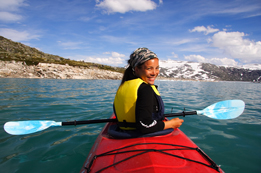Discover

© Maridav/10972488/Fotolia
Try This 1
You and a friend have just returned from a weeklong river-kayaking trip. You drove to Dinosaur Provincial Park, paddled 145 km upstream on the Red Deer River to Drumheller, and then paddled back to Dinosaur Provincial Park. You estimate that you spent 48 h in the water, paddling the entire time. From previous experience you know that you paddle at about 8 km/h. Suppose that you were interested in how fast the river was moving during your trip.
- Let r be the average speed of the river in kilometres per hour.
Complete the following table.
Distance (km)
Average Speed (km/h) Time (h) Upstream 145
8 − r
Downstream 145
- Use your times from the table and the total time taken for the trip to write an equation.

-
- Describe as many ways as you can to estimate or determine r from the equation you wrote in question 2.
- Use one of the strategies you listed to determine r to one decimal place.

- Which r-value should you choose? What does the other value represent?
-
- Graph the two functions
 and y2 = 48.
and y2 = 48. - What occurs at r = 4 on your graph? Explain why this occurs.
- Graph the two functions
![]() Save your responses in your course folder.
Save your responses in your course folder.
Share 1
With a partner or group, discuss the following questions based on the information in Try This 1.
- Describe a strategy that allows you to use the graph of a rational function to estimate the solution(s) to a rational equation.
- Describe an easier way to estimate the river speed, if you were at the river, than that used in Try This 1.
![]() If required, save a record of your discussion in your course folder.
If required, save a record of your discussion in your course folder.